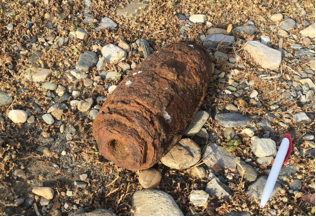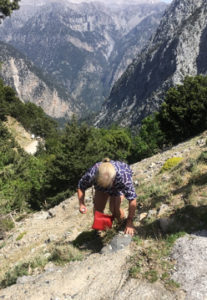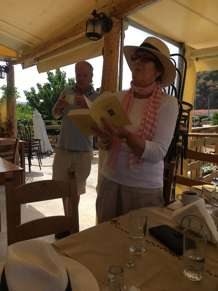
Crete, in 1941, was a disaster for the locals, the Australians and their Allies – as well as the Germans. But out of this terrible campaign came Australian stories of fortitude, heroism and loss.
In May, 2018, a group of descendants from Victoria, NSW, WA and UK went to Crete to follow the stories of family members on a trip that took us over much of Crete with its rugged and raw mountains; its ancient towns, cities and structures. But above all, to meet its local people with whom there is a special bond with Australians that was forged over a few extraordinary months 77 years ago. The trip was the work of organiser and military historian Bim Affleck and his wife, Anna.
Our group went to the places and met some of the descendants of the people who were important to three uncles and a father who were variously in the Australian infantry battalions as well as the 2/3rd Light Anti-Aircraft Regiment in 1941. But their stories and experiences would be similar to many in 7th Battery of the latter Regiment who served on Crete. Our group thus represented Doug Craig (senior) and Alec Dawkins who were taken off by the navy to the safety of Egypt, Jim Carstairs who successfully evaded the occupying forces for six months and Max Whiteside who died of wounds sustained at Maleme airfield on the first day of the first – and last – major airborne invasion.


As narrator, this account begins with my arrival in Patras, Greece, from where I drove to Athens via amemorial to the village of Kalavryta where the male population over 12yo (some 700 souls) was wiped out in Nazi reprisals in 1943. Kalavryta is now on the tourist bus route so the world can remember the horror of what was done and resolve for it never to happen again.
But life must go on ….

The contrasts of Greece! … On a back road through the mountains of the Peloponnese, this shepherd and his flock walk a scene that goes back to biblical times.
Then south east to Nafplion where there were over a hundred multi-million € ‘gin palaces’ tied up in the harbour in a champagne-fuelled sales pitch to the rich and famous.

Quite a contrast from 1941 when this harbour was the scene of many hurried escapes via naval ships bound for Crete after the Germans overtook Greece.
My final destination on the mainland was Athens and its Phaleron Commonwealth War Cemetery where Sergeant Max Whiteside is buried. Max was in charge of a Bofors anti-aircraft gun and these were the first targets in the initial airborne attack on Crete on 20/5/1941. He was seriously wounded and was hidden by his mates in the foothills for a couple of days and then flown back to hospital in Athens by the Germans before he died of wounds on 25/5/1941 aged 22. He was in the 7th Battery of the Australian 2/3rd LAA Regiment while my father Charles Luckock and uncle Griff Weatherly were in the 9th Battery of the same regiment. 9th Battery were also ear-marked for Crete before it fell but stayed in North Africa to be “well chased by Rommel” in what they jokingly called ‘the Benghazi Handicap’! 8th Battery were proudly ‘Rats of Tobruk’.


Then the ferry from Piraeus to Chania in Crete on a beautiful moonlit night … ….. to arrive the following morning into Souda Bay – peaceful now, but the scene of furious fighting in 1941.

Our group of Crete excursionaries then visited the nearby Commonwealth War Cemetery and established our base in the delightful Doma Hotel in Chania.
The Doma is owned by two elderly sisters and was once the British Consul and subsequently the German Headquarters during the occupation.

L to R Norm Craig, Bim Affleck (organiser), Julie Hope, Janet Gordon, Lachie Gordon, Pin Affleck, Anna Affleck, Russell Luckock, Jules Craig, Joy Craig, Sophie Holloway, Doug Craig.
So began our excursions to various points around Crete in hired cars with local driver/guide, Manos.
Maleme airfield and German War Cemetery
In 1941 Maleme airfield (pron Mal-em-ma) was the centre of the early German airborne attack using fighter and transport planes, towed gliders, and paratroops.

This photo shows the Maleme airfield which is now used for military purposes with tight security.

On the beach side of the airfield, this concrete construction for a gun-emplacement may be the remains of the base for the light anti-aircraft Bofors 40mm guns which were unfortunately and unwisely concreted in much to the dismay of the 2/3rd when they arrived. For the regiment’s usual practice in North Africa was to move the Bofors on their 4 wheels at night when expecting an attack – so that the Germans did not know where these effective anti-aircraft guns would be situated the following morning. (The concrete might also be subsequent German construction during their occupation.)
Max Whiteside’s letters home in early May 1941 said he ‘was 400 yards from the beach’ – so swims were part of their day in the Australian tradition. So I decided to have a swim for Max. Walking along the beach at the north side of the airfield, I was half-expecting to be followed by a military drone or some-such!
However, when driving beside the airfield on my return trip, I just happened to stop for a few minutes – only to look up to see two heavily armed and helmeted Greek soldiers taking a great interest in why I had stopped opposite a military airfield…… Needless to say, my stop was particularly brief!
The beach side of the Maleme airfield seems much as it was in 1941.

Is this still live!??
Photo in Nautical Museum of Crete, Akti Kountourioti St, Chania, Crete

This 1941 photo of Maleme airfield was on display in the museum in Chania and shows the dust and carnage of the initial airborne attack. The high ground at right is probably Hill 107 which was strategically important with its commanding view of the surrounding territory, including the Maleme airfield that was defended by 2/3rd LAA Bofors guns. The local Allied command headquarters was sited on the Hill until its capture by the Germans.
Max Whiteside would be somewhere in this photo.

The tragedy of war affects all sides. German losses in this massive airborne attack were horrendous such that Hitler banned their subsequent use. Photo shows the German War Cemetery on the south side of what was Hill 107.

While I was in the WW2 section of Chania’s Nautical Museum I was approached by a young man who had heard me speaking English and wanted to know why I was there. I explained. It turned out that he was a young German, born in East Germany now living outside Heidelberg, and he, Bert Lissner (right) and his girlfriend Cathleen were very concerned about what had been done in the past in their country’s name. We were joined by a Belgian couple (Leo, centre, and Marie-Paule Vande Velde) for an interesting discussion of what and why it had all happened.
42nd Street:
Another excursion in Chania was to 42 nd Street where Bim explained the battle and its consequences. Especially the short-term effects of the Maori regiment’s impromptu Haka attack led by the brilliant New Zealanders.

Brothers Norm (dark blue shirt) and Doug Craig (green shirt) were in Crete to follow their uncle who had managed to escape out of mainland Greece when it fell and then went aboard a navy ship from Chora Sfakien to Alexandria.
The battle for Crete lasted only a short time as the Germans managed to out-manoeuvre the ill-equipped Allied forces many of whom had only recently escaped from Greece with little equipment – especially for communications. It was touch and go until the Germans captured Maleme airfield, after which the Allied troops had to fight rear-guard actions and head south to a small fishing port on the south coast that faced across the Mediterranean to Egypt.
But first they had to scramble over the 2,450 m high White Mountains with its gorges that were the walking tracks in these seriously steep ranges.
Imbros Gorge

The intrepid walkers in our group set out to walk down the Imbros Gorge. And reached the bottom after some two hours twenty minutes.
It’s a different story from walking back up as Jim Carstairs and his mates had to do after the navy ships departed Chora Sfakien without this rear-guard group. Back in 1941, boots were continually falling apart in the very rough, rocky terrain so that troops’ feet sometimes were wrapped in anything they could find or, worse still, in bare feet.


The heights and extremes to which some plant aficionados will go! Enthusiastic gardener Sophie discovers a plant that needs a closer look.
But this is seriously steep country … Indeed, the photographer was castigated for clicking the shutter rather than performing a gallant rescue!! But it clearly illustrates the type of country that the Allied troops had to traverse.
Askifou Museum:
There is a private military museum at Askifou near the Imbros Gorge with an old Bofors anti-aircraft gun outside – this one unusually equipped with a shield – and a good supply of raki for sale.
While I missed the group visit to this museum I hear say afterwards that there was a good deal of rakiing with the local Cretans who are well-known for their enthusiastic hospitality to Australians.

Chora Sfakien
The tiny fishing port on the south coast – from where many Allied troops were evacuated by various naval ships and transported to Alexandria in Egypt. Jim Carstairs’s Battalion, the Australian 2/7th however, formed the rear-guard that allowed the time to load the ships with escaping troop formations. They were eventually ordered to evacuate so scrambled down the steep slopes to the beach – but the ships had gone for good.
The Battalion was then lined up on the beach in formal order by their Commanding Officer, Colonel Theo Walker. He addressed his troops by saying that he considered it his duty to surrender to the Germans and to look after all who came with him. However, anyone who wanted to take their chances and escape was welcome to do so.
Many decided to try their luck (and skill) in evading the Germans until things quietened down and escape to Egypt could be organised. Jim Carstairs and his mates set off to scramble back up the mountains – this time with the extra threat from the ever-present German patrols.

This was a poignant moment for these troops. Having decided not to surrender on the Chora Sfakien beach, these men now faced the hell of climbing back up those blasted mountains – with their boots in tatters and short of food and particularly water – but also having to avoid enemy troops. They were now on their own and had to rely on their Australian-learned wits and skills.
On our group’s drive back up these steep mountain switchback roads, I was privileged to have Doug Craig as my passenger. The Peugeot purred … and Doug broke into the best recital of the The Man From Snowy River– that iconic Australian poem by Banjo Paterson – that I have ever heard. His spirited rendition and colouration were most memorable!
Together, we rode those ‘horses’ up, up ever upwards until we landed at the top of that terrible ascent. For Dougie sent the poetic flintstones flying in this rough and broken ground where many mountain gullies meet …. amongst these torn and rugged battlements on high!
A masterful recitation of an Australian masterpiece!

Vafes:At right, Janet Gordon reads from Jim Carstairs’ book at the group lunch at Vafes in central Crete where Jim was sheltered and fed by the local Cretans at great risk to themselves.
Local medicine was always interesting – especially when Jim had a severe bout of jaundice and his progress was followed closely by constant visits from the locals which was a problem if German patrols were in the area.
Patsos and the Cretan Network of Andartes.
The Cretans during the occupation proved a formidable force working with the Allies – and on their own – against the German occupation of their island.
We stayed a night in Patsos where a small rock shelter outside the village was important during the German occupation of their island.
We stayed a night in Patsos where a small rock shelter outside the village was important during the German occupation. Our guide, Vasilis explained the 1941 situation when, Evangelos Vandoulakis, and other locals hid Jim Carstairs at great risk to themselves and their village. They became great friends and this was the pattern between many Cretans and the Australians and New Zealanders in particular.
This friendship was apparent to me in September 1984 during a beach holiday near Rethymnon. One day, I drove up high into the White Mountains on my way to Chora Sfakien and stopped at a tiny shop in goat country with mountainous rocks and scrub – to come across an old walking-sticked man sitting outside. He wanted to know where I was from.
When we worked out ‘Australia’ he became most animatedly excited. “Australia gut: Germans nicht gut” he said in the language of the occupation that he had obviously witnessed.
In a separate 1944 operation conducted by British SOE officers Paddy Leigh Fermor and W.S. ‘Billy’ Moss with some locals, the German General Kreipe, in charge of Crete, was abducted and hidden in this same Patsos ‘cave’ before being walked over the mountains and thence to Egypt and captivity. In a famous literary incident while on the slopes of Mt Ida, the General quoted the first verse of Horace’s Ode 1.9 in Latin then stopped. Upon which Patrick Leigh Fermor finished it off – both from memory – learned during their pre-war years!

An Escape and a Capture
After visiting the Prevelli Monastery – the scene of many Allied escapes organised by these very brave church leaders – I departed the group as I had to head to Heraklion and home in a couple of days.
But first I drove to the small Peristere Beach, just a few hundred metres from Rodakino, from which General Kreipe was evacuated to Egypt and captivity by the British.
Upon asking the local café owner about tourism, he said there are now many German tourists coming to enjoy the south coast beaches as an escape from their northern winter.

Tris Ekklisies and Safety– A beach at the very small village of Tris Ekklisies (three churches) on the coast due south of Heraklion is where Jim Carstairs and a group of 78+ Allied troops escaped to Alexandria and freedom on the caique affectionately referred to as ‘HMS’ Hedgehog.
On the day I visited there had been significant rainfall so the main street was flooded just above the beach. I did not venture through this floodwater as a conked-out car would be inadvisable in this very remote village!
The beach is at the foot of a number of very steep mountainous ranges that now have a glorious newly-tarred road which descends in a series of serious switchbacks. No doubt, European Union funds at work.
The new, wide tar, however, ends abruptly at the entrance to the village – so you then encounter pot-holed, stony, narrow streets!
Just imagine in 1941, though, descending these steep, rocky, mountains with your boots in tatters … but finally … they had escaped!


Postcript:But from all this comes hope. Hope epitomised by the busloads of tourists now stopping to witness the civilian massacre sites in Greece – and the young German couple who openly expressed their dismay to me at what had been done in the past in their country’s name.
Lest we forget.
Reading:
Carstairs, James de Mole, Escape from Crete: War Diary 1941, Society of Cretan Historical Studies, Heraklion, 2016. (Available from Historical Museum of Crete, Heraklion, €10 + p & p)
Rae, C J E, Harris, A L and Bryant, R K: On Target: The Story of the 2/3rd Light Anti-Aircraft Regiment. Enterprise Press, 1987.
2/3rd Light Anti-Aircraft Regiment website article on 2/4th LAA Bofors in the North Africa desert: https://www.antiaircraft.org.au/take-post/take-post-articles/days-in-the-desert
